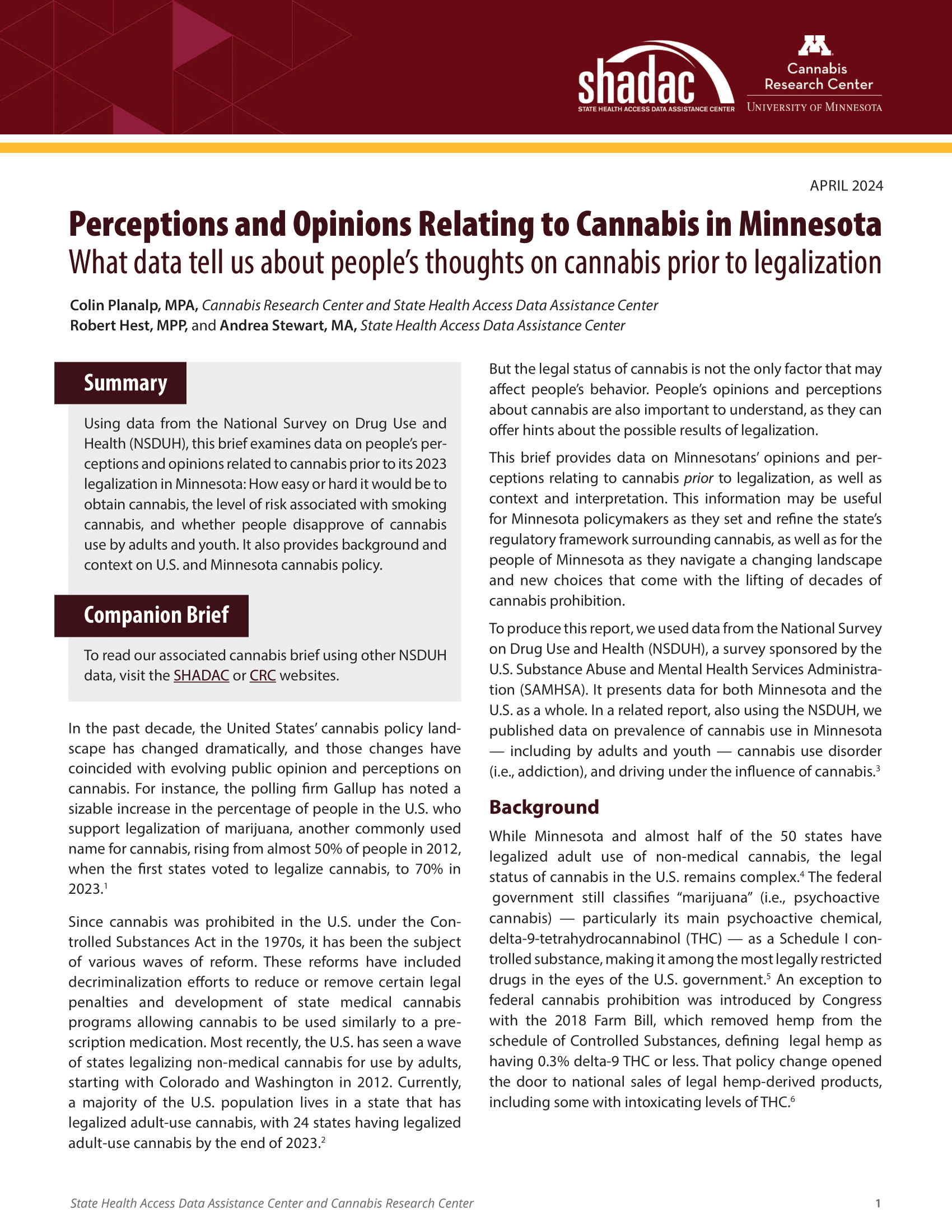Blog & News
Measuring Perceptions and Opinions on Cannabis Use and Access in Minnesota
April 18, 2024:Even before legalization, most Minnesotans reported that cannabis was easy to obtain; only one-third disapproved of use by adults
During the past decade, the United States’ cannabis policy landscape has changed dramatically. By the end of 2023, 24 states had legalized cannabis for non-medical use by adults — meaning the majority of the U.S. population lives in a state with legalized recreational cannabis.
These changes in the landscape of U.S. cannabis policy have coincided with evolving public opinion and perceptions about cannabis and cannabis legalization. Researchers have documented changing public attitudes about cannabis policy. For example, according to the polling firm Gallup, the share of people in the U.S. who support legalization of marijuana has grown from 50% in 2012 to 70% in 2023, just over a decade later1. But the complexities of cannabis and the attitudes surrounding it are much more nuanced than simply whether people support or oppose cannabis legalization.
In 2023, Minnesota became the 23rd state to legalize cannabis for non-medical use by adults. To help policymakers and Minnesotans understand the potential public health implications of that policy change, researchers from the University of Minnesota School of Public Health’s State Health Access Data Assistance Center (SHADAC) and the newly formed Cannabis Research Center (CRC) have analyzed data on people’s perceptions and opinions relating to cannabis, both for Minnesota and the U.S. as a whole.
SHADAC and the CRC used data from the federal government’s National Survey on Drug Use and Health (NSDUH). This research so far has included a focus on pre-legalization data, to better understand the people’s perspectives, opinions, and experiences with cannabis before Minnesota’s policy shift. Using the NSDUH, we report pre-legalization baseline data on several issues and commonly cited concerns associated with cannabis legalization:
- Ease or difficulty of obtaining cannabis under a policy of prohibition
- Perceived risk of smoking cannabis on a weekly basis
- Disapproval, or lack of disapproval, of cannabis use by adults (age 18 and older) and youth (age 12-17)
These particular measures are important because they may offer hints about the potential public health effects of cannabis legalization. Much of the concern about legalization hinges on the assumption that it will increase cannabis use, in turn resulting in possible consequences such as increases in prevalence of cannabis use disorder. But is it not clear whether legalization will increase cannabis use in the Minnesota context, or whether increased cannabis use will result in subsequent harms.
Data on Minnesotans’ perceptions and opinions of cannabis can offer us clues as to how legalization might affect the state. In our analysis, we found that most Minnesotans age 12 and older reported that cannabis was very or fairly easy to obtain, even before it was legalized. That could mean that increased availability of cannabis through legalization might not have a substantial impact on use, as people already reported easy availability when cannabis was prohibited.
We also found that roughly half of Minnesotans believed that smoking cannabis once or twice a week carried no risk or only slight risk of harm. And, while our analysis found that only one in three Minnesota adults (age 18 and older) reported disapproving of adults using cannabis, four in five Minnesota youth (age 12 to 17) said they disapproved of peers using cannabis. That suggests that adults may be less inhibited to try cannabis than youth under legalization — though those attitudes could change.
Our plan is to continue monitoring the cannabis landscape in Minnesota, measuring the impacts of legalization and the consequences — positive or negative — for public health. The findings of this study offer us early hints, but it will be crucial to continue to research these issues once commercial sales of cannabis begin and as new data become available.
Find more details and data analysis in the full version of this brief by clicking on the image to the right, or at the link here.
Interested in Minnesota cannabis policy and research? Check out the following resources to learn more about this growing field:










